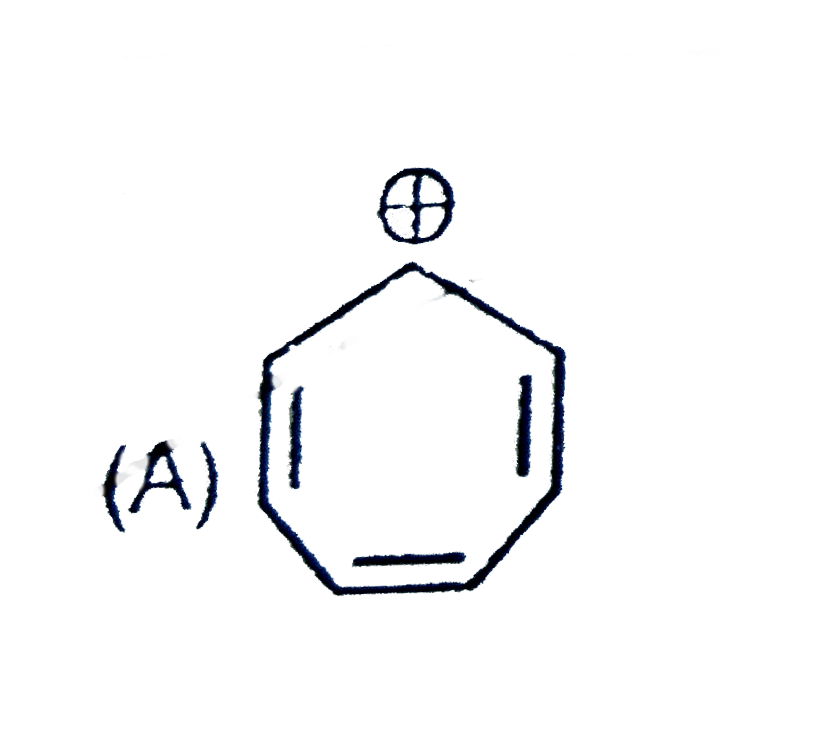From the compound shown below, choose which is/are aromatic.




The correct Answer is:A, C, D
To determine which of the given compounds are aromatic, we need to apply the criteria for aromaticity. A compound is considered aromatic if it meets the following conditions:
1. It must be cyclic.
2. It must be planar.
3. It must have a complete conjugated system (alternating single and double bonds).
4. It must contain 4n+2 π electrons, where n is a non-negative integer.
Now, let's analyze each compound step by step.
Step 1: Analyze Compound A
- Count π Electrons:
- The structure has 6 π electrons (2 from each double bond).
- Check Conjugation:
- The compound shows complete conjugation with alternating double and single bonds.
- Planarity:
- The compound is planar.
- Aromaticity Check:
- It satisfies the 4n+2 rule (where n=1).
Conclusion: Compound A is aromatic.
Step 2: Analyze Compound B
- Count π Electrons:
- This compound has 10 π electrons.
- Check Conjugation:
- It shows conjugation with alternating double and single bonds.
- Planarity:
- However, due to hydrogen-hydrogen repulsion, one hydrogen atom is pushed out of the plane, disrupting planarity.
- Aromaticity Check:
- Although it has 10 π electrons, the loss of planarity means it cannot be aromatic.
Conclusion: Compound B is not aromatic.
Step 3: Analyze Compound C
- Count π Electrons:
- This compound also has 10 π electrons.
- Check Conjugation:
- It shows complete conjugation with alternating double and single bonds.
- Planarity:
- The compound is planar.
- Aromaticity Check:
- It satisfies the 4n+2 rule (where n=2).
Conclusion: Compound C is aromatic.
Step 4: Analyze Compound D
- Count π Electrons:
- This compound has 4 π electrons (2 from each double bond).
- Check Conjugation:
- It shows complete conjugation.
- Planarity:
- The compound is planar.
- Aromaticity Check:
- It does not satisfy the 4n+2 rule (it has 4 π electrons which fits 4n, where n=1), thus it is not aromatic.
Conclusion: Compound D is not aromatic.
Final Summary:
- Aromatic Compounds: A and C
- Non-Aromatic Compounds: B and D
2. It must be planar.
3. It must have a complete conjugated system (alternating single and double bonds).
4. It must contain 4n+2 π electrons, where n is a non-negative integer.
- Count π Electrons:
- The structure has 6 π electrons (2 from each double bond).
- Check Conjugation:
- The compound shows complete conjugation with alternating double and single bonds.
- Planarity:
- The compound is planar.
- Aromaticity Check:
- It satisfies the 4n+2 rule (where n=1).
Conclusion: Compound A is aromatic.
- Count π Electrons:
- This compound has 10 π electrons.
- Check Conjugation:
- It shows conjugation with alternating double and single bonds.
- Planarity:
- However, due to hydrogen-hydrogen repulsion, one hydrogen atom is pushed out of the plane, disrupting planarity.
- Aromaticity Check:
- Although it has 10 π electrons, the loss of planarity means it cannot be aromatic.
- Count π Electrons:
- This compound also has 10 π electrons.
- Check Conjugation:
- It shows complete conjugation with alternating double and single bonds.
- Planarity:
- The compound is planar.
- Aromaticity Check:
- It satisfies the 4n+2 rule (where n=2).
Conclusion: Compound C is aromatic.
- Count π Electrons:
- This compound has 4 π electrons (2 from each double bond).
- Check Conjugation:
- It shows complete conjugation.
- Planarity:
- The compound is planar.
- Aromaticity Check:
- It does not satisfy the 4n+2 rule (it has 4 π electrons which fits 4n, where n=1), thus it is not aromatic.
- Aromatic Compounds: A and C
- Non-Aromatic Compounds: B and D
Topper's Solved these Questions
- TEST PAPERSBook:RESONANCE ENGLISHChapter:TEST PAPERSExercise:Chemistry
Explore 701 Videos
- TEST PAPERSBook:RESONANCE ENGLISHChapter:TEST PAPERSExercise:PT-01
Explore 30 Videos
- TEST PAPERSBook:RESONANCE ENGLISHChapter:TEST PAPERSExercise:PART - III CHEMISTRY
Explore 46 Videos
- SURFACE CHEMISTRYBook:RESONANCE ENGLISHChapter:SURFACE CHEMISTRYExercise:Section - 5
Explore 1 Video
- TEST SERIESBook:RESONANCE ENGLISHChapter:TEST SERIESExercise:CHEMISTRY
Explore 50 Videos
Similar Questions
Knowledge Check
Which of the compounds shown below are isomers?
A B
B C
C D
D
The IUPAC name of the compound shown below is
 A2-bromo-6-chlorocyclohex-1-eneB6-bromo-2-chlorocyclohexeneC3-bromo-1-chlorocyclohexeneD1-bromo-3-chlorocyclohexene.
A2-bromo-6-chlorocyclohex-1-eneB6-bromo-2-chlorocyclohexeneC3-bromo-1-chlorocyclohexeneD1-bromo-3-chlorocyclohexene.Which one of the compounds shown below, is not an isomer of the others ?
A B
B C
C D
D
Which compound(s) out of the following is/are not aromatic?

View SolutionFrom the organic compounds given below, choose one compound in case which relates to the description
[Ethyne, ethanol, acetic acid, ethene]
An organic compound whose functional group is carboxyl.
View SolutionFrom the organic compounds given below, choose one compound in case which relates to the description
[Ethyne, ethanol, acetic acid, ethene]
An organic compound used as a thermometric liquid.
View SolutionFrom the organic compounds given below, choose one compound in case which relates to the description
[Ethyne, ethanol, acetic acid, ethene]
A hydrocarbon which on catalytic hydrogenation gives a saturated hydrocarbon.
View SolutionFrom the organic compounds given below, choose one compound in case which relates to the description
[Ethyne, ethanol, acetic acid, ethene]
An unsaturated hydrocarbon used for welding.
View Solution
